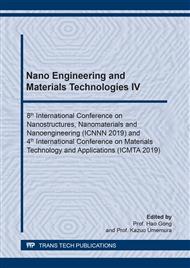[1]
Andalib, Ramin et al. 2016. Optimum Concentration of Bacillus Megaterium for Strengthening Structural Concrete., Construction and Building Materials 118: 180–93. http://dx.doi.org/10.1016/j.conbuildmat.2016.04.142.
DOI: 10.1016/j.conbuildmat.2016.04.142
Google Scholar
[2]
Zakari, Nasiru et al. 2016. Tests and Methods of Evaluating the Self-Healing Efficiency of Concrete : A Review., CONSTRUCTION & BUILDING MATERIALS 112: 1123–32. http://dx.doi.org/10.1016/j.conbuildmat.2016.03.017.
Google Scholar
[3]
Sharma, T K et al. 2017. Alkaliphilic Bacillus Species Show Potential Application in Concrete Crack Repair by Virtue of Rapid Spore Production and Germination Then Extracellular Calcite Formation.,.
DOI: 10.1111/jam.13421
Google Scholar
[4]
Wiktor, Virginie, and Henk M Jonkers. 2011. Cement & Concrete Composites Quantification of Crack-Healing in Novel Bacteria-Based Self-Healing Concrete., Cement and Concrete Composites 33(7): 763–70. http://dx.doi.org/10.1016/j.cemconcomp. 2011.03.012.
DOI: 10.1016/j.cemconcomp.2011.03.012
Google Scholar
[5]
Jonkers, H M. 2011. Bacteria-Based Self-Healing Concrete., 56(1): 1–12.
Google Scholar
[6]
Tittelboom, Kim Van, and Nele De Belie. 2013. Self-Healing in Cementitious Materials—A Review.
Google Scholar
[7]
Vijay, Kunamineni, Meena Murmu, and Shirish V Deo. 2017. Bacteria Based Self Healing Concrete – A Review., Construction and Building Materials 152: 1008–14. http://dx.doi.org/10.1016/j.conbuildmat.2017.07.040.
DOI: 10.1016/j.conbuildmat.2017.07.040
Google Scholar
[8]
Siddique, Rafat, and Navneet Kaur. 2011. Effect of Ureolytic Bacteria on Concrete Properties.,Construction and Building Materials 25(10): 3791–3801. http://dx.doi.org/10.1016/j.conbuildmat.2011.04.010.
DOI: 10.1016/j.conbuildmat.2011.04.010
Google Scholar
[9]
Chaurasia, Leena, Vishakha Bisht, L P Singh, and Sanjay Gupta. 2019. A Novel Approach of Biomineralization for Improving Micro and Macro-Properties of Concrete., Construction and Building Materials 195: 340–51. https://doi.org/10.1016/j.conbuildmat.2018.11.031.
DOI: 10.1016/j.conbuildmat.2018.11.031
Google Scholar
[10]
Jonkers, Henk M et al. 2010. Application of Bacteria as Self-Healing Agent for the Development of Sustainable Concrete., Ecological Engineering 36: 230–35.
DOI: 10.1016/j.ecoleng.2008.12.036
Google Scholar
[11]
Wang, Jianyun, Yusuf Cagatay Ersan, Nico Boon, and Nele De Belie. 2016. Application of Microorganisms in Concrete : A Promising Sustainable Strategy to Improve Concrete Durability., Appl Microbiol Biotechnol (100): 2993–3007.
DOI: 10.1007/s00253-016-7370-6
Google Scholar
[12]
Chahal, Navneet, Rafat Siddique, and Anita Rajor. 2012. Influence of Bacteria on the Compressive Strength, Water Absorption and Rapid Chloride Permeability of Concrete Incorporating Silica Fume., Construction and Building Materials 37: 645–51. http://dx.doi.org/10.1016/j.conbuildmat.2012.07.029.
DOI: 10.1016/j.conbuildmat.2012.07.029
Google Scholar
[13]
Achal, Varenyam, Abhijeet Mukerjee, and M Sudhakara Reddy. 2013. Biogenic Treatment Improves the Durability and Remediates the Cracks of Concrete Structures., CONSTRUCTION & BUILDING MATERIALS 48: 1–5. http://dx.doi.org/10.1016/j.conbuildmat.2013.06.061.
DOI: 10.1016/j.conbuildmat.2013.06.061
Google Scholar
[14]
Khaliq, Wasim, and Muhammad Basit Ehsan. 2016. Crack Healing in Concrete Using Various Bio Influenced Self-Healing Techniques., Construction and Building Materials 102: 349–57.
DOI: 10.1016/j.conbuildmat.2015.11.006
Google Scholar
[15]
Siddique, Rafat et al. 2016. Properties of Bacterial Rice Husk Ash Concrete., Construction and Building Materials 121: 112–19. http://dx.doi.org/10.1016/j.conbuildmat.2016.05.146.
DOI: 10.1016/j.conbuildmat.2016.05.146
Google Scholar
[16]
Pei, Ruoting, Jun Liu, Shuangshuang Wang, and Mijia Yang. 2013. Use of Bacterial Cell Walls to Improve the Mechanical Performance of Concrete., Cement and Concrete Composites 39: 122–30. http://dx.doi.org/10.1016/j.cemconcomp.2013.03.024.
DOI: 10.1016/j.cemconcomp.2013.03.024
Google Scholar


